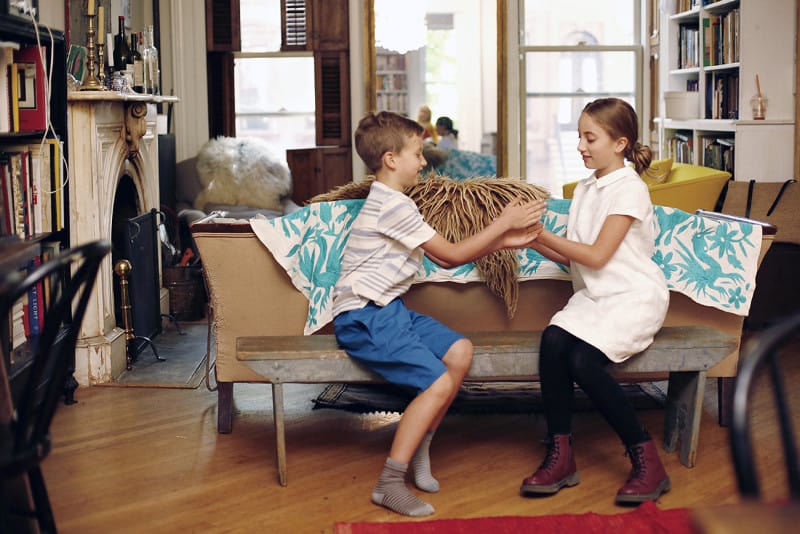
The Importance of Kids Having Opposite Sex Friends
Written by Sara Langer
Photography by Kate Huling's Home, PHOTOGRAPHED BY BELATHÉE PHOTOGRAPHY
Making progress toward gender equality is an ongoing endeavor. Gender norms and stereotypes and are so deeply ingrained in culture and media, this effort will need to be continued for years to come. So, while men and women are inching their way toward becoming equals in American society, a troubling fact remains—young children are often still pushed toward gendered toys, clothing, activities, and even friendships, starting in infancy. Today we’re tackling the latter topic—opposite sex friendships—why they’re beneficial, and how you can foster friendships across gender lines for your own kiddos.
Gender segregation starts at a very young age, but you can be proactive.
Gender segregation occurs because of nature and nurture. An excerpt from the book Child Development Principles and Perspectives discusses the cognitive schema that children develop around gender. “Children develop ideas, or schemas, about what boys and girls are typically like. These concepts include stereotyped and exaggerated notions about gender differences, for example: ‘Boys are rough and like to fight and play with trucks’ and ‘Girls are nice and like to talk and play with dolls.’ Children use these cognitive schemas as filters when they judge themselves and observe other children. ‘I am a boy, so I like to play with trucks’ is a concept that may lead boys to seek each other as playmates. As children learn gender-based schemas, their play and playmate preferences become more segregated.” Because of this, children may be missing opportunities to explore new interests and relationships from a young age. A 2015 New York Times piece on gender and toys suggests that the toys a young child plays with can influence what they choose to study and ultimately their career. Simply being aware of gender-norms and trying not to steer your child in one direction or another will be helpful. Follow your child and their interests, but try not to push them toward something just because it’s a “boy-thing” or a “girl-thing.” The same goes for friendships.
Biological differences between the developing female and male brain exist, but experiences will play a role, too.
When it comes to friendships, children as young as 2 and 3 may already begin to show a preference for playing with children of the same gender. By age 5 or 6, children are likely to spend most of their playtime with their same-gender friends. There are many reasons children may choose to play with others of the same sex. Some research suggests that socially, boys and girls play differently and differences in the brain can exist in very young children. Studies show girls tend to be more advanced than boys in language development, while boys are often more advanced with spatial-skills. Because of this, we may see differences in how children play or who they choose to play with. Early friendships with those of the opposite sex, however, may expose your child to different types of play and the opportunity to develop new skills.
Encourage co-ed activities outside of school.
If your school reinforces gender segregation (many do so unconsciously), it may be easier for children to befriend a child of the opposite sex outside of the classroom. Opposite sex friendships that are common are often neighbors, siblings of friends, family friends, or peers in co-ed activities. Providing your child with different opportunities to participate in co-ed extracurricular activities is a great way to facilitate these types of relationships. You can also take the initiative to organize get-togethers and playdates with your child’s peers, both male and female, and double check your kid’s birthday party guest list to make sure it’s not too lopsided. Try a mix of one-on-one playdates and getting a group of kids of different genders together, and help pick activities and games that’ll unite instead of divide.
Drop the romantic “boyfriend” and “girlfriend” language.
How you talk about gender, the roles you take on at home, and the friendships you and your kids have with different gender people, will influence your children as they are developing their own ideas and beliefs. Be aware of your language. For example, it is far too common for an adult to explain a pair of toddler friends, a boy, and a girl, as “future girlfriend and boyfriend.” This only reinforces binary gender norms and the idea that males and females cannot have platonic relationships. Meanwhile, the goal is to normalize boys and girls interacting in a friendly way.
Teens can benefit from opposite gender friends.
Beyond pre-school and elementary, nurturing cross-gender relationships into the teen years can be extremely beneficial for young adults. Learning to communicate and socialize with different genders will better prepare young people for the many relationships they will encounter in their adult lives, both personally and professionally. Being friends with those of the opposite sex during the formative adolescent years will expose young people to many personalities and perspectives, ultimately widening their worldview and helping to build empathy and mutual respect for their peers, male or female. If teens can have healthy, platonic relationships with different types of people, it may make some things easier for them later on. A 2017 survey from The New York Times found that “Around a quarter of people think private work meetings with colleagues of the opposite sex are inappropriate and nearly two-thirds say people should take extra caution around members of the opposite sex at work.” Because of this old-school way of thinking, both men and women may be missing out on opportunities in the workplace because of gender segregation, favoritism, and lack of cross-gender mentorship.
Lead by example.
We can probably all attest to the fact that we learned a lot about relationships (the good and bad) from our parents. If a child doesn’t see the adults in his or her life modeling healthy, platonic opposite sex relationships, they may not be as likely to naturally make those types of friendships on their own. Even if you don’t have one specific person of the opposite sex that you are friends with, consider hosting groups of men and women at your home for social get-togethers. Seeing adults modeling these types of relationships is a great way for children to see it as normal.
Opposite sex friends may be more common in the future.
According to sociologist Michael Kimmel, “Millennials are far more likely than their older peers to see a non-sexual friendship between men and women as normal.” As more millennials become parents, children will likely be exposed to the normalization of opposite sex friendships in adults. And as men and women continue to work toward more egalitarian roles at home and work, children will be exposed to a variety of relationships dynamics, regardless of sex or gender.
Don’t force it.
All this being said, some children may simply gravitate towards friends of the same gender. And there is no need to push these relationships if your child doesn’t want them and you can certainly combat any drawbacks of gender segregation without forcing your child to be friends with someone. There is nothing wrong with your child aligning with gender norms and expectations if you are following their lead and interests, without pushing them in one direction or another. The goal here is more about awareness of how we talk about and encourage cross-gender friendships and the fruitful role they can have in our kids’ lives.
For more on this topic check out our pieces on How to Talk to Kids About Gender, Kids Books that Challenge Gender Norms, How to Fight Gender Stereotypes in the Media, and How to Help Foster Childhood Friendships.
Share this story




